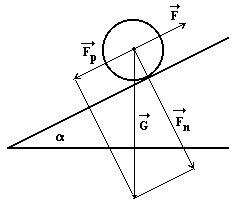Inclined plane
On the inclined plane with an inclination angle of 30°, we will put the body (fixed point) with mass 9 kg. Determine the acceleration of the body motion on an inclined plane.
Final Answer:

Tips for related online calculators
You need to know the following knowledge to solve this word math problem:
geometryplanimetricsgoniometry and trigonometryUnits of physical quantitiesthemes, topicsGrade of the word problem
We encourage you to watch this tutorial video on this math problem: video1
Related math problems and questions:
- Motion on circle
 The bend has a radius of r = 100 m and is inclined at an angle of 20° to the horizontal plane (= tilt angle). What is the safe (the "best") speed to go through this curve? Sketch the picture regarding NIVS, mark the forces, and calculate.
The bend has a radius of r = 100 m and is inclined at an angle of 20° to the horizontal plane (= tilt angle). What is the safe (the "best") speed to go through this curve? Sketch the picture regarding NIVS, mark the forces, and calculate. - The body
 The body slides down an inclined plane, forming an angle α = π / 4 = 45° under the action of a horizontal plane under the effect of friction forces with acceleration a = 2.4 m/s². At what angle β must the plane be inclined so that the body slides on it af
The body slides down an inclined plane, forming an angle α = π / 4 = 45° under the action of a horizontal plane under the effect of friction forces with acceleration a = 2.4 m/s². At what angle β must the plane be inclined so that the body slides on it af - Inclined plane
 1. How much work W do we have to do to pull a body weighing 200 kg along an inclined plane with a length of 4 m to a total height of 1.5 m? 2. Find the force we need to exert to do this if we neglect frictional resistance. 3. Find the force we would need
1. How much work W do we have to do to pull a body weighing 200 kg along an inclined plane with a length of 4 m to a total height of 1.5 m? 2. Find the force we need to exert to do this if we neglect frictional resistance. 3. Find the force we would need - Acceleration 83305
 A body of mass 500 kg is lifted with a uniformly accelerated rectilinear motion using a rope. Determine the acceleration at which the rope breaks if it sustains a load of 15,000 N.
A body of mass 500 kg is lifted with a uniformly accelerated rectilinear motion using a rope. Determine the acceleration at which the rope breaks if it sustains a load of 15,000 N. - Inclined plane
 The body stays on an inclined plane and exerts a compressive force of 70N on it. Find the angle between the inclined plane and the horizontal if a gravitational force of 100N acts on the body.
The body stays on an inclined plane and exerts a compressive force of 70N on it. Find the angle between the inclined plane and the horizontal if a gravitational force of 100N acts on the body. - A kite 3
 A kite is flying at a height of 60 m above the ground. The string attached to the kite is temporarily tied to a point on the ground. The inclination of the string with the ground is 60°. Find the length of the string, assuming that there is no slack in th
A kite is flying at a height of 60 m above the ground. The string attached to the kite is temporarily tied to a point on the ground. The inclination of the string with the ground is 60°. Find the length of the string, assuming that there is no slack in th - Elevation of the tower
 We can see the top of the tower standing on a plane from a certain point A at an elevation angle of 39°25''. If we come towards its foot 50m closer to place B, we can see the top of the tower from it at an elevation angle of 56°42''. How tall is the tower
We can see the top of the tower standing on a plane from a certain point A at an elevation angle of 39°25''. If we come towards its foot 50m closer to place B, we can see the top of the tower from it at an elevation angle of 56°42''. How tall is the tower
